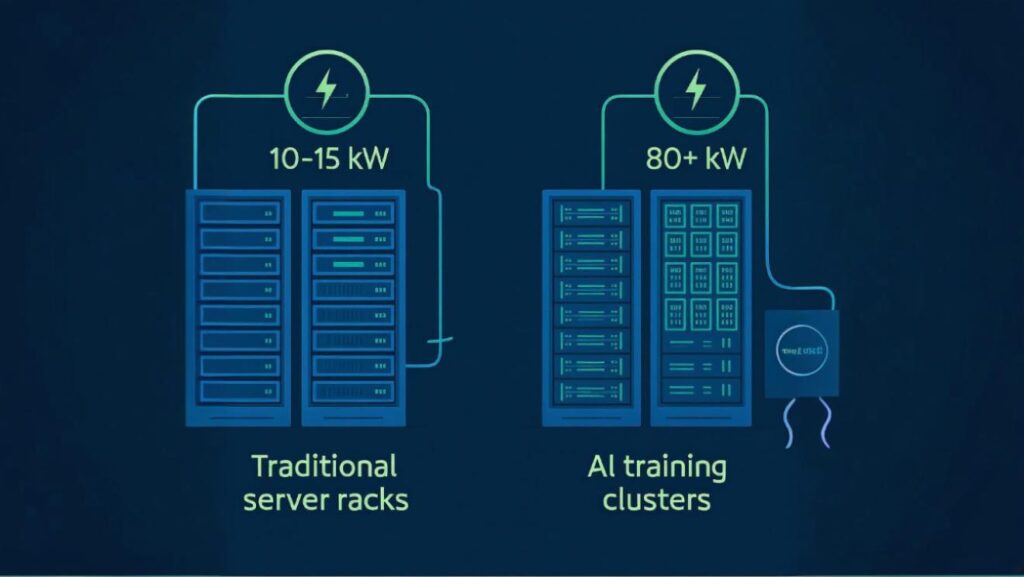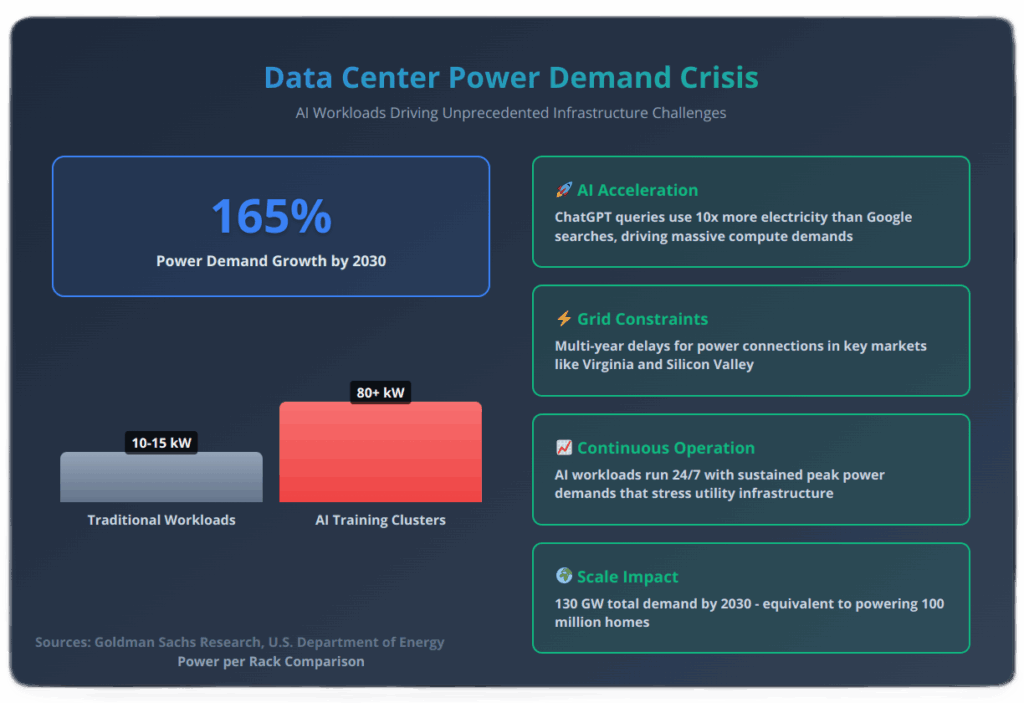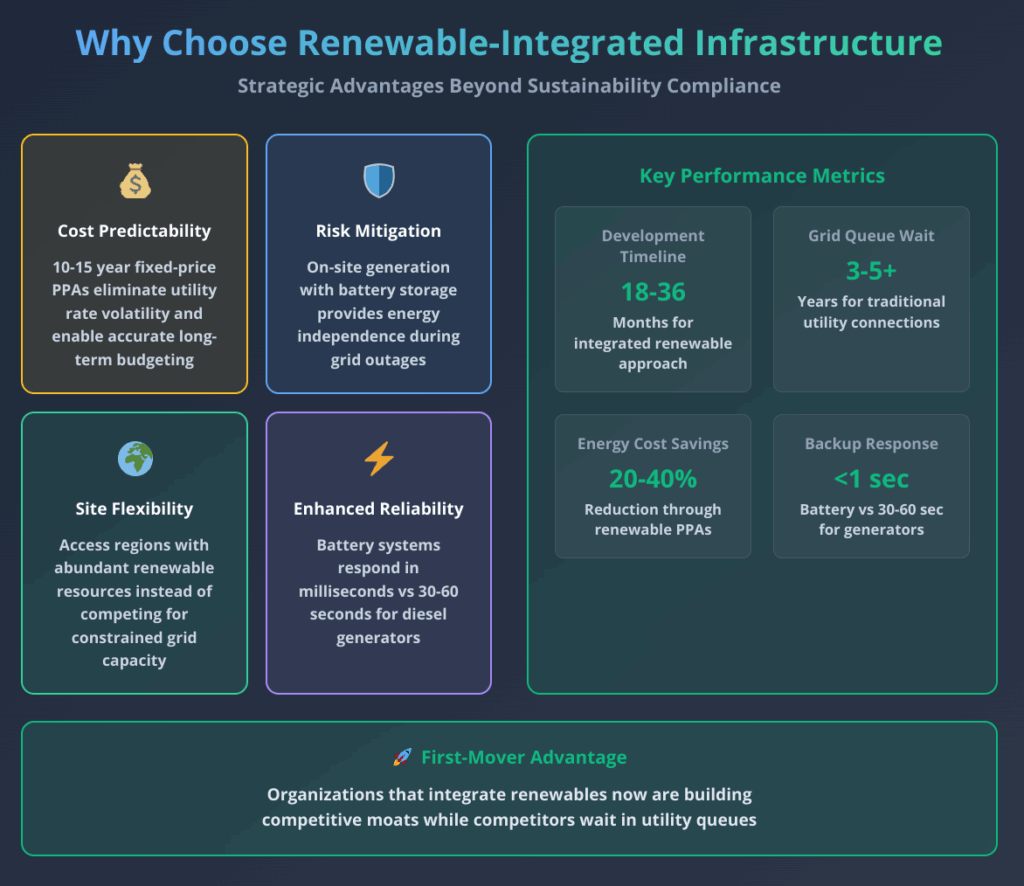SUMMARY: The Strategic Imperative. Companies that integrate renewable energy into their digital infrastructure planning gain cost predictability and enhanced reliability for AI and cloud workloads. With data center power demand projected to increase 165% by 2030, organizations that fail to plan for renewable integration face multi-year grid delays and escalating energy costs that threaten competitive positioning.
The data center industry is experiencing a perfect storm of unprecedented infrastructure challenges. AI workloads are driving exponential power demand growth just as grid constraints are tightening across key markets. Microsoft’s recent announcement that it abandoned data center projects representing 2 gigawatts of electricity in the U.S. and Europe perfectly illustrates the complex capacity planning dynamics that hyperscalers now face.
What makes this situation particularly challenging is that traditional approaches to infrastructure development simply aren’t working anymore. Major tech companies are finding themselves in multi-year queues for utility connections in prime markets, watching energy costs climb while their competitive windows narrow. Your digital infrastructure solutions can’t afford to depend on these increasingly unreliable grid-dependent strategies.
Consider the scale of what’s coming: according to the U.S. Department of Energy, data center electricity demand could reach 130 GW by 2030, representing 12% of total U.S. annual demand. We’re looking at a fundamental transformation of how America consumes power, not just incremental growth. The organizations that get ahead of this shift by treating renewable energy as a strategic infrastructure component, rather than just another sustainability checkbox, will own the next decade of digital growth.
So here’s the real question you need to answer: How quickly can you execute renewable integration before your competitors gain an insurmountable advantage? The choice to integrate renewables into your digital infrastructure plan has already been made by market forces.
What Makes Digital Infrastructure Planning Critical Right Now?
You’re dealing with a convergence of forces that traditional infrastructure approaches simply can’t handle. AI workloads, regulatory pressure, and grid constraints have created an infrastructure planning crisis where the old playbook falls short and actively puts you at a competitive disadvantage.
The numbers tell the story clearly. AI workloads consume significantly more power per computation than anything you’ve planned for before. According to Goldman Sachs Research, a single ChatGPT query requires nearly 10 times as much electricity to process as a Google search. When you scale that to AI training clusters requiring 80 kW per rack compared to the 10-15 kW you’re used to with conventional equipment, you’re looking at infrastructure demands that run continuously and push utility grids beyond their limits.

Meanwhile, the infrastructure you need to support this demand growth hasn’t kept pace. In Virginia, home to the world’s largest concentration of data centers, new power connections now require multi-year lead times that can kill project timelines. You’re seeing the same bottlenecks in Silicon Valley, Phoenix, and Dublin. Recent analysis from McKinsey confirms what you’re probably experiencing firsthand: time to power has become the primary constraint for data center development, surpassing even real estate availability and fiber connectivity.
The regulatory environment is adding another layer of complexity that you can’t ignore. The European Union now mandates that data centers over 500 kW report renewable energy consumption, along with other sustainability metrics including energy consumption, water usage, and waste heat utilization. Similar requirements are emerging across U.S. states, with California leading comprehensive energy efficiency standards for digital infrastructure.
What’s really driving urgency, though, are the corporate sustainability commitments reshaping your vendor relationships. Microsoft has committed to being carbon negative by 2030, while Amazon pledged net-zero carbon by 2040, creating downstream pressure on enterprise customers to demonstrate renewable energy usage. If you can’t show progress on renewable integration, you risk losing access to preferred cloud services and enterprise partnerships that your business depends on.

How Does Renewable Energy Integration Transform Your Digital Infrastructure Strategy?
Here’s where renewable integration changes everything about how you approach infrastructure development. Instead of accepting whatever power the local utility offers (whenever they can deliver it), you gain control over energy sourcing, costs, and reliability. This goes beyond sustainability to deliver operational and financial advantages that traditional approaches can’t match.
The cost predictability alone makes a compelling business case. Traditional utility rates fluctuate with fossil fuel markets and regulatory changes, making long-term budgeting a guessing game. Power Purchase Agreements (PPAs) with renewable generators provide fixed-price electricity for 10-15 years, giving you the kind of cost certainty that CFOs love. Google’s recent partnership with Intersect Power demonstrates exactly how co-located renewable generation reduces both costs and timeline risks while ensuring reliable power delivery.
But the risk mitigation benefits might be even more important for your operations. On-site or near-site renewable generation with integrated storage gives you something traditional grid connections can’t: genuine energy independence during critical moments. During the Texas winter storms in 2021, data centers with integrated solar and battery systems maintained operations while grid-dependent facilities went dark. Instead of relying on diesel generators with their fuel supply chain vulnerabilities, renewable energy campuses provide clean backup power that doesn’t depend on external logistics.
Perhaps most importantly, renewable integration expands your site selection options dramatically. Rather than limiting development to established utility markets where everyone’s competing for the same constrained grid capacity, you can access regions with abundant solar and wind resources. This geographic flexibility often opens up development opportunities with significantly lower land costs and reduced competition, while still meeting your power requirements.
The operational benefits extend beyond cost and reliability. Enhanced grid stability emerges when renewable energy systems include battery storage. Modern energy storage systems provide grid services like frequency regulation and peak shaving, potentially generating additional revenue streams while supporting your primary digital infrastructure needs. You’re not just buying power—you’re creating a strategic energy asset.
What Are the Five Essential Elements of Renewable-Integrated Digital Infrastructure Planning?
Successful renewable integration requires coordinated planning across multiple infrastructure systems. These five elements form the foundation of effective energy-integrated digital development.

1. Strategic Site Selection Based on Renewable Resource Availability
Location decisions must prioritize renewable energy potential alongside traditional factors like fiber connectivity and land costs. Sites with excellent solar irradiance or consistent wind patterns enable higher capacity factors and better economic returns from renewable installations. Strategic site selection and readiness requires comprehensive evaluation of renewable resource quality alongside traditional infrastructure considerations.
Geographic diversification reduces weather-related risks while accessing different renewable resources. A portfolio approach might include solar-dominant sites in the Southwest, wind-heavy locations in the Midwest, and hybrid resources in transition zones. The Department of Energy notes that data center electricity demand has specific characteristics requiring strategic regional distribution to optimize both renewable access and grid stability.
Transmission access becomes critical for sites that will interconnect renewable generation. Proximity to high-capacity transmission lines enables grid-scale renewable development that can support multiple data center phases while potentially serving external markets.
2. Co-location Planning for Generation and Consumption
Integrated energy campuses co-locate renewable generation with data center facilities, minimizing transmission losses while maximizing operational control. This approach reduces interconnection timelines by treating energy and digital infrastructure as unified projects rather than separate developments. How renewable energy powers data centers demonstrates how co-location strategies create both operational and financial advantages.
Shared infrastructure reduces capital costs when generation and consumption facilities share electrical equipment, maintenance operations, and security systems. Co-location enables economies of scale that standalone facilities cannot achieve.
Phased development strategies allow energy and digital infrastructure to scale together. Initial phases might emphasize solar generation with battery storage, while later expansions could add wind resources or advanced technologies like green hydrogen production.
3. Energy Storage Integration for Reliability
Battery energy storage systems bridge the gap between intermittent renewable generation and constant digital infrastructure demands. Modern systems provide several hours of backup power while supporting grid services that generate additional revenue.
Multiple storage technologies optimize different operational requirements. Short-duration batteries handle minute-to-minute fluctuations, while longer-duration systems provide extended backup power during multi-day weather events.
Intelligent energy management systems coordinate storage charging and discharging with renewable generation forecasts and digital infrastructure demand patterns. Machine learning algorithms optimize these operations in real-time, maximizing both reliability and economic performance. Advanced energy solutions combine multiple storage technologies with predictive analytics to ensure consistent power delivery regardless of renewable generation variability.
4. Grid Interconnection Strategy
Multiple utility connections provide redundancy while enabling renewable energy sales during periods of excess generation. Dual-fed substations eliminate single points of failure while creating opportunities for demand response participation.
Behind-the-meter strategies reduce utility charges while maintaining grid connection for backup power. This approach minimizes demand charges and transmission fees while preserving access to grid stability services.
Microgrid capabilities enable island operation during grid disturbances. Advanced control systems automatically disconnect from the utility grid during outages while maintaining critical digital infrastructure operations using on-site renewable generation and storage. AI-driven power optimization requires sophisticated grid interconnection strategies that can support both normal operations and emergency scenarios.
5. Scalability Planning for Future Expansion
Modular infrastructure design accommodates changing technology and capacity requirements. Standardized building blocks enable rapid deployment while maintaining operational consistency across multiple sites and development phases.
Technology roadmap integration ensures infrastructure can accommodate emerging technologies like green hydrogen, advanced geothermal, or small modular nuclear reactors. Future-proofing reduces stranded asset risks while enabling competitive advantages from early technology adoption.
Financial structure optimization balances capital efficiency with operational flexibility. Strategies might include equipment leasing, power purchase agreements, or energy-as-a-service models that reduce upfront capital requirements while maintaining long-term cost advantages.
How Are Leading Companies Successfully Implementing Renewable Digital Infrastructure?
The companies that are winning this transition aren’t just talking about renewable integration—they’re fundamentally rethinking how digital infrastructure gets built. They’re moving beyond traditional utility-dependent models toward integrated energy strategies that create genuine competitive advantages across multiple dimensions.

Google’s recent announcement represents exactly this kind of paradigm shift. The company partnered with Intersect Power and TPG Rise Climate to develop industrial parks with gigawatts of data center capacity co-located with new clean energy plants. What makes this significant isn’t just the scale—it’s the timeline. The first phase expects operational status by 2026, demonstrating how “power first” approaches can cut delivery timelines significantly while bypassing traditional grid constraints entirely.
This strategy directly addresses America’s grid planning crisis, where typical development timelines have doubled from less than two years to more than four years for projects built between 2018-2023. When you create purpose-built, right-sized clean energy for specific digital infrastructure needs, you eliminate the grid bottlenecks that are killing traditional development approaches.
Federal initiatives are creating new opportunities that smart operators are already exploring. The Department of Energy recently identified 16 federal sites for potential data center and energy infrastructure development, with aggressive development timelines to support American AI leadership. These sites offer existing energy infrastructure with potential for fast-track permitting for new generation including nuclear options—exactly the kind of integrated approach that reduces development risk.
What’s particularly interesting is how corporate Power Purchase Agreement strategies continue evolving beyond simple renewable energy procurement toward comprehensive infrastructure partnerships. Instead of just purchasing renewable energy credits from distant generators, leading companies are establishing long-term partnerships with energy developers who can provide integrated solutions including site development, generation, storage, and ongoing operations.
The most successful implementations we’re seeing combine multiple renewable technologies while maintaining operational flexibility. Hybrid solar-wind-storage systems provide more consistent power profiles than single-technology approaches, while smart control systems optimize generation and consumption patterns in real-time. This approach creates energy infrastructure that actually works better than traditional alternatives, going well beyond sustainability compliance.
What Challenges Should You Expect When Integrating Renewables?
Let’s be realistic about what you’re getting into. Renewable integration introduces complexities that traditional infrastructure planning doesn’t address, and understanding these challenges upfront enables more effective mitigation strategies and realistic timeline planning.
The technical integration requirements are probably more sophisticated than your team expects. You’ll need control systems that coordinate renewable generation, energy storage, and digital infrastructure demands while responding to weather forecasts, utility market signals, and computational workload changes—all while maintaining power quality and reliability standards that your operations demand.
Equipment procurement timelines often exceed those for conventional infrastructure, sometimes significantly. High-capacity inverters, battery energy storage systems, and specialized transformers can require extended lead times that could derail your project schedule if you don’t plan accordingly. Supply chain management becomes absolutely critical for avoiding costly delays.
The permitting landscape gets more complex when projects combine renewable generation with digital infrastructure. You’ll likely be dealing with multiple regulatory agencies that may have overlapping jurisdiction, requiring coordination between utility commissions, environmental agencies, and local planning departments. Streamlined approaches often require experienced development partners who understand these regulatory pathways and can navigate them efficiently.
Interconnection studies and utility coordination can extend project timelines significantly, especially for large renewable installations. Grid impact assessments may require extensive review periods, while interconnection agreements involve complex negotiations over equipment specifications, protection systems, and operational procedures. The utility coordination alone can add months to your development schedule.
Financial modeling becomes more sophisticated when projects include multiple revenue streams from digital infrastructure operations, renewable energy sales, and grid services. Traditional project finance approaches may not accommodate the risk profiles and cash flow patterns of integrated developments, requiring more creative financing structures.
Here’s something many organizations underestimate: workforce requirements expand beyond traditional data center expertise to include renewable energy operations, energy storage management, and grid interconnection specialists. You’ll need to develop internal capabilities or establish partnerships with experienced renewable energy operators—and that talent pool is already stretched thin.
How to Build Your Renewable-Integrated Digital Infrastructure Plan
Building an effective renewable integration strategy starts with understanding exactly where you are today and where you need to go. This requires a systematic approach that balances current operational realities with future growth requirements while identifying the right partnerships to make it all work.
Begin with a comprehensive assessment of your existing digital infrastructure energy consumption patterns. You need detailed analysis of demand profiles, peak usage periods, and reliability requirements to establish a solid baseline. This groundwork enables accurate sizing of renewable generation and storage systems while revealing opportunities for demand optimization that can improve your overall project economics.
Your site evaluation process needs to expand beyond traditional factors to prioritize renewable resource quality. Solar irradiance data, wind resource assessments, and transmission access analysis should inform site selection decisions just as much as fiber connectivity and land costs. If you’re considering geographic diversification strategies, plan for multiple site assessments to optimize portfolio-wide renewable integration rather than making decisions site by site.
Technology selection becomes a strategic decision that depends on your specific operational requirements and local resource availability. Sites with excellent solar resources might emphasize photovoltaic systems with battery storage, while locations with consistent wind patterns could prioritize wind generation with complementary technologies. The key is matching technology choices to both your operational needs and the natural resources available at each location.
For most organizations, partner evaluation becomes the make-or-break decision in this process. Unless you have deep internal renewable energy expertise, you’ll need partners with proven renewable development experience, established utility relationships, solid financing capabilities, and operational expertise you can count on. Integrated energy campus developers offer turnkey solutions that reduce complexity while accelerating deployment timelines, which can be invaluable when you’re trying to move quickly in competitive markets.
Your financial analysis needs to account for multiple value streams that traditional infrastructure planning doesn’t consider. Energy cost savings, carbon reduction benefits, operational resilience improvements, and potential revenue from excess renewable generation all factor into the equation. Life-cycle cost analysis typically demonstrates superior returns for renewable-integrated approaches compared to traditional utility-dependent strategies, but you need the right analytical framework to capture all the benefits.
Implementation planning requires careful coordination across energy and digital infrastructure development timelines to avoid costly delays or mismatched capacity. Phased approaches often work best, beginning with renewable generation and storage systems, followed by digital infrastructure deployment as energy systems achieve operational status. This sequencing reduces risk while ensuring your energy infrastructure can support your digital infrastructure from day one.
Finally, performance monitoring systems should track both energy and digital infrastructure performance to optimize integrated operations over time. Advanced analytics platforms can identify opportunities for efficiency improvements while ensuring reliability standards are maintained, turning your infrastructure into a continuously improving strategic asset rather than just a fixed cost center.
Frequently Asked Questions
How long does it typically take to develop renewable-integrated digital infrastructure?
Integrated development typically requires 18-36 months from site selection to operational status, compared to multi-year timelines for traditional grid-dependent approaches in constrained markets. The timeline advantage comes from treating energy and digital infrastructure as unified projects rather than separate developments requiring independent utility interconnections.
What are the main cost differences between renewable-integrated and traditional digital infrastructure?
While renewable integration requires higher upfront capital investment, long-term operational costs benefit from predictable energy pricing through power purchase agreements, reduced utility demand charges, and potential revenue from excess renewable generation during periods of lower digital infrastructure demand.
Can renewable energy systems provide the same reliability as traditional grid connections?
Modern renewable systems with integrated battery storage often provide superior reliability compared to traditional grid connections. Battery energy storage systems respond to power quality issues in milliseconds, while backup diesel generators require 30-60 seconds to start. Multiple renewable technologies and storage systems create redundancy that single utility connections cannot match.
What regulatory approvals are required for renewable-integrated digital infrastructure projects?
Regulatory requirements vary by jurisdiction but typically include environmental impact assessments, utility interconnection agreements, building permits, and renewable energy facility licenses. Projects that co-locate generation and consumption often qualify for streamlined permitting processes compared to separate developments requiring independent approvals.
Your Infrastructure Strategy Starts Now
The transformation of digital infrastructure planning from grid-dependent strategies to renewable-integrated approaches represents one of the most significant shifts in enterprise technology infrastructure in decades. This goes far beyond another industry trend to fundamentally change how organizations approach infrastructure development. The organizations that recognize renewable energy as a strategic infrastructure component are gaining competitive advantages across cost management, operational resilience, and scalability planning that their competitors simply can’t match.
The stakes keep rising as AI workloads drive unprecedented power demands while grid constraints create multi-year delays for traditional development approaches. Every month you delay renewable integration is another month your competitors have to establish energy-secured positions in key markets. The companies that are moving first are building competitive moats that will be increasingly difficult for others to cross, going well beyond basic future-proofing of their infrastructure.
Success in this new environment requires moving beyond conventional thinking about energy as a commodity you simply purchase from whoever can deliver it. The most effective implementations treat renewable generation, energy storage, and digital infrastructure as unified systems designed to work together from the ground up. This level of integration demands deep technical expertise combined with strategic vision to create sustainable competitive advantages.174 Power Global specializes in helping organizations navigate this transformation through comprehensive energy solutions for data centers that integrate renewable generation, storage, and site development into turnkey solutions. Our team brings decades of experience in utility-scale renewable development and digital infrastructure together to deliver integrated approaches that accelerate deployment timelines while reducing the complexity of managing multiple vendors and coordinating separate development tracks. Contact us to discuss how renewable integration can transform your digital infrastructure strategy and position your organization for the energy-constrained future that’s already here.



